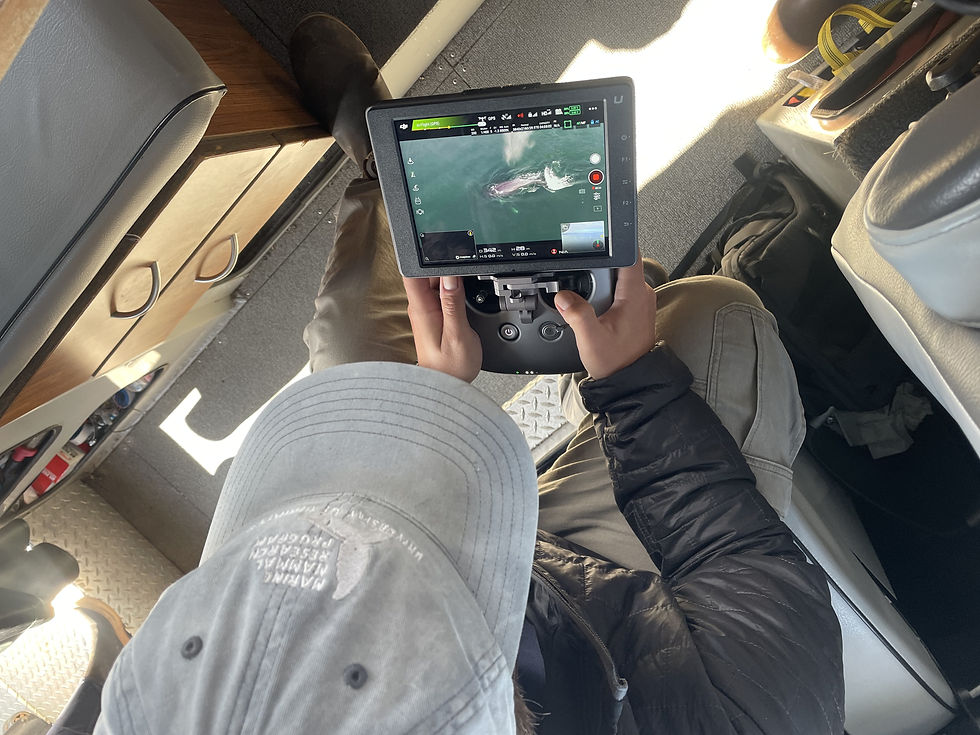Alaska Whale Foundation Research Report: September, 2023
- AWF Team
- Oct 16, 2023
- 3 min read

Month at a Glance:
Effort:
Days on the water: 5
Sampling stations: 46
Total # ID: 149
Drone flights: 38
Biopsies: 18
Nutrient samples: 115
CTD casts: 46
Whale poop samples: 3
Whale Numbers:
Number of unique whales: 130 (Total for year: 813)
Number of cow-calf pairs: 8 (Total for year: 31)
Bubble-netting groups: 4
Number of unique bubble-netters: 26 (Total for year: 137)

Above: Distribution of humpback whales photo-identified during September 2023. Size of red circles reflects group size (smallest circle = 1, largest = >16 whales). Triangles represent locations of surveyed “Point Count” stations for estimating whale abundance; these provide an indication of where photo-identification efforts were conducted (and, due to weather, were not).
Research Overview:
September proved to be a difficult month for our systematic surveys. An atmospheric river brought heavy rains and high winds, which largely kept the field team off the water. As a result, the team was only able to visit 46 of the 108 survey stations over four days of systematic surveys.
In total, they photo-identified 130 unique whales, 70 of which were new for the year, and recorded five cow-calf pairs. Of the whales sighted in September, 72% have been seen on breeding grounds. Of those, 77% were seen in Hawaii, 18% were seeing in Mexico, and 4% have been seen in both Hawaii and Mexico. No whales from either the Western North Pacific of Central American breeding grounds were encountered.

In addition to our sampling efforts, three members of our field team assisted in a partial necropsy of a beached whale in South Hoonah Sound / Peril Strait. This effort was coordinated by Sadie Wright, NOAA's Alaska Regional Large Whale Entanglement and Oil Spill Response Coordinator, and led on the ground by Dr. Lauren Wild (University of Alaska Southeast). The team collected skin, blubber, eye and baleen samples for a broad health analysis. They found no markings to indicate a clear cause of death; however, the whale's dorsal side, where ship strike trauma would be most evident, was not visible. A photo-identification image of the whale's fluke was matched to a well-known and well-loved male whale, Epimeletic. The first record of Epimeletic we have in our database comes from Fred Sharpe’s research in 1995, but other researchers had encountered him in 1970s.

About AWF's Field Work:
Each month from June through September, the AWF team visits up to 108 survey stations that are evenly distributed throughout the study region. At each station, the team conducts a 15min 'point count' and records the location of every whale they observed. At the same time, they deploy probes that measure ocean salinity, temperature and chlorophyll concentrations - the latter a proxy for phytoplankton biomass - from the surface to a depth of ~50m. They also collect water samples to measure nutrient concentrations. These data provide a detailed picture of the water column’s physical and chemical structure throughout the study region.
After completing the point count, the team then travels to each whale they observed to collect photo-identification images, launch Unoccupied Aerial Systems (“drones”) to measure the body volume of individual whales, and collect biopsy samples to measure hormone concentrations, stable isotope ratios (for reconstructing diet) and examine genetic profiles. Once all these data have been collected, the team travels to the next station and repeats the process. It takes a minimum of 9 days to complete each survey; however, it can take far longer if weather and whales are uncooperative.
About AWF's Research Reports
AWF aims to bridge the gap between scientists, stakeholders, and the public by communicating our general research findings through publicly available reports and information brochures. These reports provide up-to-date information on the status of Southeast Alaska humpback whales and are intended to serve as resources for local communities, stakeholders, policymakers, and educators.
Stay tuned for monthly reports during our field season from June-September, as well as an annual research report released every fall. You can also sign up for our newsletter below and visit this page to support AWF's research financially.
Yorumlar